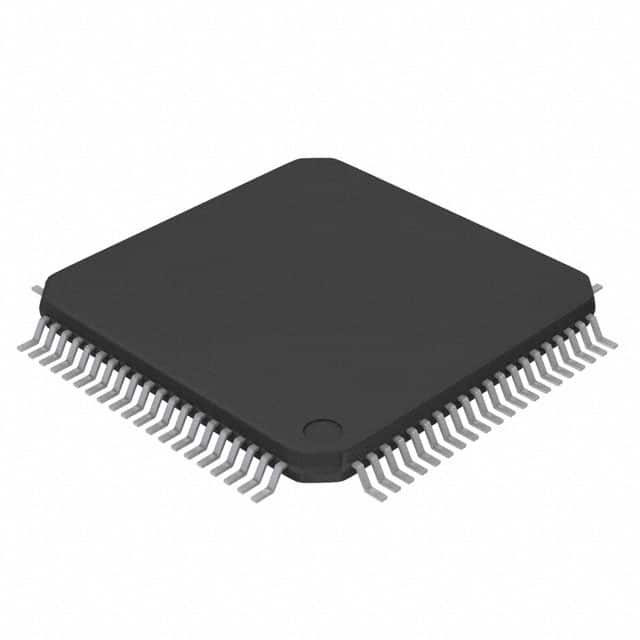Szczegóły produktu można znaleźć w specyfikacjach.

MC9S08AC128MLKE
Product Overview
- Category: Microcontroller
- Use: Embedded systems, consumer electronics, industrial automation
- Characteristics: Low power consumption, high performance, small form factor
- Package: LQFP (Low-profile Quad Flat Package)
- Essence: A microcontroller designed for various applications requiring low power and high performance.
- Packaging/Quantity: Available in reels of 2500 units
Specifications
- CPU: 8-bit S08 core
- Clock Speed: Up to 40 MHz
- Flash Memory: 128 KB
- RAM: 4 KB
- Operating Voltage: 2.7V to 5.5V
- I/O Pins: 56
- Communication Interfaces: UART, SPI, I2C
- Analog-to-Digital Converter (ADC): 10-bit resolution, 16 channels
- Timers: 8-bit and 16-bit timers
- Operating Temperature Range: -40°C to +85°C
Detailed Pin Configuration
The MC9S08AC128MLKE microcontroller has a total of 56 I/O pins. The pin configuration is as follows:
- VDD - Power supply voltage
- VSS - Ground
- PTA0 - General-purpose I/O pin
- PTA1 - General-purpose I/O pin
- PTA2 - General-purpose I/O pin
- PTA3 - General-purpose I/O pin
- PTA4 - General-purpose I/O pin
- PTA5 - General-purpose I/O pin
- PTA6 - General-purpose I/O pin
- PTA7 - General-purpose I/O pin
- PTB0 - General-purpose I/O pin
- PTB1 - General-purpose I/O pin
- PTB2 - General-purpose I/O pin
- PTB3 - General-purpose I/O pin
- PTB4 - General-purpose I/O pin
- PTB5 - General-purpose I/O pin
- PTB6 - General-purpose I/O pin
- PTB7 - General-purpose I/O pin
- PTC0 - General-purpose I/O pin
- PTC1 - General-purpose I/O pin
- PTC2 - General-purpose I/O pin
- PTC3 - General-purpose I/O pin
- PTC4 - General-purpose I/O pin
- PTC5 - General-purpose I/O pin
- PTC6 - General-purpose I/O pin
- PTC7 - General-purpose I/O pin
- PTD0 - General-purpose I/O pin
- PTD1 - General-purpose I/O pin
- PTD2 - General-purpose I/O pin
- PTD3 - General-purpose I/O pin
- PTD4 - General-purpose I/O pin
- PTD5 - General-purpose I/O pin
- PTD6 - General-purpose I/O pin
- PTD7 - General-purpose I/O pin
- PTE0 - General-purpose I/O pin
- PTE1 - General-purpose I/O pin
- PTE2 - General-purpose I/O pin
- PTE3 - General-purpose I/O pin
- PTE4 - General-purpose I/O pin
- PTE5 - General-purpose I/O pin
- PTE6 - General-purpose I/O pin
- PTE7 - General-purpose I/O pin
- RESET - Reset pin
- IRQ - Interrupt request input
- BKGD - Background debug mode pin
- VDDA - Analog power supply voltage
- VREFH - High reference voltage for ADC
- VREFL - Low reference voltage for ADC
- VSSA - Analog ground
- AD0 - Analog input 0
- AD1 - Analog input 1
- AD2 - Analog input 2
- AD3 - Analog input 3
- AD4 - Analog input 4
- AD5 - Analog input 5
- AD6 - Analog input 6
Functional Features
- Low power consumption: The MC9S08AC128MLKE microcontroller is designed to operate efficiently with minimal power consumption, making it suitable for battery-powered applications.
- High performance: With a clock speed of up to 40 MHz and a powerful 8-bit S08 core, this microcontroller offers fast and reliable processing capabilities.
- Small form factor: The LQFP package ensures a compact size, making it ideal for space-constrained applications.
- Versatile communication interfaces: The UART, SPI, and I2C interfaces enable seamless connectivity with other devices and peripherals.
- Analog-to
Wymień 10 typowych pytań i odpowiedzi związanych z zastosowaniem MC9S08AC128MLKE w rozwiązaniach technicznych
Sure! Here are 10 common questions and answers related to the application of MC9S08AC128MLKE in technical solutions:
Q: What is MC9S08AC128MLKE? A: MC9S08AC128MLKE is a microcontroller from the S08 family, specifically designed for embedded applications.
Q: What are the key features of MC9S08AC128MLKE? A: Some key features include a 8-bit CPU core, 128KB flash memory, 4KB RAM, multiple communication interfaces, and analog peripherals.
Q: What kind of technical solutions can be built using MC9S08AC128MLKE? A: MC9S08AC128MLKE can be used in various applications such as industrial control systems, home automation, automotive electronics, and consumer electronics.
Q: How can I program MC9S08AC128MLKE? A: MC9S08AC128MLKE can be programmed using assembly language or high-level languages like C/C++. Development tools like CodeWarrior or IAR Embedded Workbench can be used.
Q: Does MC9S08AC128MLKE support real-time operating systems (RTOS)? A: Yes, MC9S08AC128MLKE can be used with popular RTOS like FreeRTOS or Micrium µC/OS-II to build complex multitasking applications.
Q: Can MC9S08AC128MLKE communicate with other devices? A: Yes, MC9S08AC128MLKE has multiple communication interfaces including UART, SPI, I2C, and CAN, enabling it to communicate with other devices or peripherals.
Q: Is MC9S08AC128MLKE suitable for low-power applications? A: Yes, MC9S08AC128MLKE has power-saving features like low-power modes and wake-up interrupts, making it suitable for battery-powered or energy-efficient applications.
Q: Can MC9S08AC128MLKE handle analog signals? A: Yes, MC9S08AC128MLKE has built-in analog peripherals such as ADC (Analog-to-Digital Converter) and DAC (Digital-to-Analog Converter) to handle analog signals.
Q: Are there any development boards available for MC9S08AC128MLKE? A: Yes, there are development boards specifically designed for MC9S08AC128MLKE, which provide easy prototyping and debugging capabilities.
Q: Where can I find documentation and support for MC9S08AC128MLKE? A: Documentation, datasheets, application notes, and support for MC9S08AC128MLKE can be found on the official website of the microcontroller manufacturer or through online communities and forums dedicated to embedded systems.

